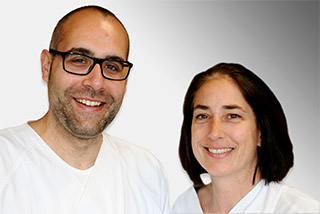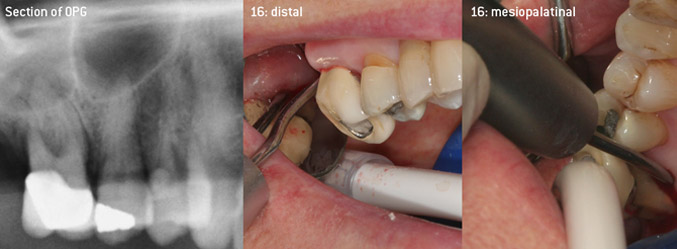Universal air scaler tip for effective furcation treatment

Report on the 3AP working tip
by Dr. Claudia Springer and Dr. Christian Graetz
The safe and effective removal of a pathological biofilm plays a decisive role in the long-term preservation of teeth when treating any periodontal diseases.
It must be performed not only during the active periodontitis treatment, but also afterwards as part of the auxiliary after-care.
In order to permit this in complicated cases with advanced attachment loss and with involvement of furcation, W&H now offers the new 3AP working tip (Figure 1) for air scalers, the ideal instrument for removing hard and soft deposits on the root surface not only atraumatically but also rapidly and efficiently.
Dr Claudia Springer and Dr Christian Graetz are both on the Periodontology faculty in the Department for Conservative Dentistry and Periodontology (Director Prof. Dr C. Dörfer) at the Kiel campus of the University Medical Center Schleswig-Holstein and were influential in the development of the new W&H diamond-coated working tip. Improvements for the mechanical removal of biofilm from root surfaces has been the focus of many studies in Kiel in recent decades [1-18]. The latest findings of ongoing studies also confirm the need for research into the effect and adverse effects of mechanical scaling.
As initiators of the development of the new diamond-coated 3AP air scaler tip, the two dentists recognized the need for improvement of the handling restrictions of the commercially available diamond-coated tips, especially during furcation treatment and when working in tight intraosseous pockets. This should be possible for both non-surgical (Figure 2) and surgical (Figure 3) procedures.

(Fotos (Figures 2 -4): © Dr. Christian Graetz)

The aim was to develop a universally applicable tip in order to avoid time-consuming tip changes. In addition, it should be easier to use the new working tips in tight intraosseous pockets from distal and at the distal furcation entrance of maxillary molars, allowing more effective use of instruments as a result. This was achieved by employing an instrument curve with a larger diameter (Figure 1), which is highly advantageous for closed debridement on teeth with advanced attachment loss and involvement of furcation in particular (Figure 4).

Following a range of different in-vitro studies with newly developed working tips with slimline designs [15, 16, 19], the authors have now also been using the diamond-coated 3AP working tip to treat patients for several months. As different studies conducted by the working group [11, 14, 16] have shown, systematic scaling is a skill requiring time and manual dexterity as well as motivation, but it is certainly not one of the most complex interventions encountered in clinical practice. The aim is to remove the micro-organisms organized in the biofilm from the exposed tooth surfaces whilst preserving the dental hard substance or at least to reduce them to a tolerable level for the individual host defence [20, 21]. This should create an almost smooth, bioacceptable root surface, which promotes the formation of an epithelial or even connective tissue attachment [20, 21].
Hand instruments are just as suited to this as mechanical scalers. The latter were originally developed to improve efficiency compared with the use of hand instruments. This is done by utilizing the kinetic energy of the oscillating working tip to process the root surfaces. Although the geometry of the oscillating working tips is basically similar in acoustic and ultrasonic scalers, it is still possible to identify differences in the various drive mechanisms, with air scalers displaying almost round/elliptical oscillations of the working tip due to their drive type and an oscillation frequency of up to 6,000 Hz [22]. In this respect, a partial advantage is evident compared with the more linearly oscillating tips of a piezoelectric drive [23] or the ovally/ovoidly oscillating tip of a magnetostrictive drive [24]. Particularly in tight intraosseous pockets when using instruments in the furcation or in cases of taut gingiva in deep gingival sulci, the low-frequency but powerful, almost circular oscillation of an air scaler tip can help to improve the efficacy with reduced destruction of the root surfaces [16]. The different types of oscillation patterns also produce a working area of different sizes, which, however, can only be achieved with both instrument families if they are held at the correct angle (Figure 5).

As studies have shown, this makes it easier for inexperienced dentists to use the instruments in the back of the buccal cavity in particular [15, 16]. A recent study showed that with corresponding systematic training with the respective instrument work with the tested Proxeo air scaler (W&H, Bürmoos, Austria) was more effective than that performed with hand instruments and ultrasonic scalers and even revealed time savings [16]. This also corresponds to the external evidence [25, 26]. Working with the mechanical scalers is also more ergonomic for the user compared with hand instruments, both in terms of the working posture and taking the loads for the wrist, elbow and shoulder joints into consideration (study results collected by the authors but not yet published).
In practice, it would appear that selection of instruments depends less on their already practically identical high efficacy and more on the accessibility of the exposed root surfaces as well as the individual dentist, his or her preferences and the structure of the practice. Nevertheless, the specific disadvantages due for example to the unavoidable aerosol formation [15] and the unpleasant sensations for the patient as a result of the coolant and suction devices as well as the noise level [27] associated with the use of mechanical instruments must not be disregarded. This can have a direct negative effect on the patient’s compliance and can put the long-term success of the entire periodontitis treatment at risk as a result of lack of cooperation on the patient’s part.
However, the wide range of instruments available in periodontitis treatment offers the dentists the possibility of switching between the specified instruments or ideally combining the different procedures together.
Bibliography
- Kahl M, Haase E, Kocher T and Ruhling A (2007) Clinical effects after subgingival polishing with a non-aggressive ultrasonic device in initial therapy. J Clin Periodontol 34:318-24.
- Kocher T (1994) Wurzeloberflächenbearbeitung bei der Parodontalbehandlung. Methoden, Hilfsmittel sowie Ergebnisse. In: Ketterl W (ed) Deutscher Zahnärztekalender. Hanser, München
- Kocher T, Fanghanel J, Schwahn C and Ruhling A (2005) A new ultrasonic device in maintenance therapy: perception of pain and clinical efficacy. J Clin Periodontol 32:425-9.
- Kocher T, Gutsche C and Plagmann HC (1998) Instrumentation of furcation with modified sonic scaler inserts: study on manikins, part I. J Clin Periodontol 25:388-93.
- Kocher T, König J, Hansen P and Rühling A (2001) Subgingival polishing compared to scaling with steel curettes: a clinical pilot study. J Clin Periodontol 28:194-9.
- Kocher T, Langenbeck M, Ruhling A and Plagmann HC (2000) Subgingival polishing with a teflon-coated sonic scaler insert in comparison to conventional instruments as assessed on extracted teeth. (I) Residual deposits. J Clin Periodontol 27:243-9.
- Kocher T and Plagmann HC (1999) Root debridement of molars with furcation involvement using diamond-coated sonic scaler inserts during flap surgery -- a pilot study. J Clin Periodontol 26:525-30.
- Kocher T, Ruhling A, Herweg M and Plagman HC (1996) Proof of efficacy of different modified sonic scaler inserts used for debridement in furcations--a dummy head trial. J Clin Periodontol 23:662-9.
- Kocher T, Ruhling A, Momsen H and Plagmann HC (1997) Effectiveness of subgingival instrumentation with power-driven instruments in the hands of experienced and inexperienced operators. A study on manikins. J Clin Periodontol 24:498-504.
- Kocher T, Tersic-Orth B and Plagmann HC (1998) Instrumentation of furcation with modified sonic scaler inserts: a study on manikins (II). J Clin Periodontol 25:451-6.
- König J, Ruhling A, Schlemme H, Kocher T, Schwahn C and Plagmann HC (2002) Learning root debridement with curettes and power-driven instruments in vitro: the role of operator motivation and self-assessment. Eur J Dent Educ 6:169-75.
- Ruhling A, Bernhardt O and Kocher T (2005) Subgingival debridement with a teflon-coated sonic scaler insert in comparison to conventional instruments and assessment of substance removal on extracted teeth. Quintessence Int 36:446-52.
- Rühling A, König J, Rolf H, Kocher T, Schwahn C and Plagmann HC (2003) Learning root debridement with curettes and power-driven instruments. Part II: Clinical results following mechanical, nonsurgical therapy. J Clin Periodontol 30:611-5.
- Rühling A, Schlemme H, Konig J, Kocher T, Schwahn C and Plagmann HC (2002) Learning root debridement with curettes and power-driven instruments. Part I: a training program to increase effectivity. J Clin Periodontol 29:622-9.
- Graetz C, Plaumann A, Bielfeldt J, Tillner A, Salzer S and Dorfer CE (2015) Efficacy versus health risks: An in vitro evaluation of power-driven scalers. J Indian Soc Periodontol 19:18-24.
- Graetz C, Schwendicke F, Plaumann A, Rauschenbach S, Springer C, Kahl M, Sälzer S and Dörfer CE (2015) Subgingival instrumentation to remove simulated plaque in vitro: influence of operators' experience and type of instrument. Clin Oral Investig 19, 987-995.
- Graetz C, Plaumann A, Bielfeldt J, Sälzer S and Dörfer CE (2014) Bearbeitung von Wurzeloberflächen: Küretten und maschinelle Scaler im Fokus. ZMK 30:746-751.
- Graetz C, Bielfeldt J, Tillner A, Plaumann A and Dörfer C (2014) Spatter contamination in dental practices – how can it be prevented? Rev Med Chir Soc Med Nat, Iaşi 118:1122-1134.
- Plaumann A, Rauschenbach S, Bielfeldt J, Springer C, Kahl M, Fawzy El-Sayed K, Dörfer CE and Graetz C (2014) Effectiveness of Biofilm Removal - Influence of Experience. IADR Program Book Abstr No 1313.
- Slots J (1979) Subgingival microflora and periodontal disease. J Clin Periodontol 6:351-82.
- Khosravi M, Bahrami ZS, Atabaki MS, Shokrgozar MA and Shokri F (2004) Comparative effectiveness of hand and ultrasonic instrumentations in root surface planing in vitro. J Clin Periodontol 31:160-5.
- Flemmig TF, Petersilka GJ, Mehl A, Rudiger S, Hickel R and Klaiber B (1997) Working parameters of a sonic scaler influencing root substance removal in vitro. Clin Oral Investig 1:55-60.
- Flemmig TF, Petersilka GJ, Mehl A, Hickel R and Klaiber B (1998) The effect of working parameters on root substance removal using a piezoelectric ultrasonic scaler in vitro. J Clin Periodontol 25:158-63.
- Flemmig TF, Petersilka GJ, Mehl A, Hickel R and Klaiber B (1998) Working parameters of a magnetostrictive ultrasonic scaler influencing root substance removal in vitro. J Periodontol 69:547-53.
- Walmsley AD, Lea SC, Landini G and Moses AJ (2008) Advances in power driven pocket/root instrumentation. J Clin Periodontol 35:22-8.
- Tunkel J, Heinecke A and Flemmig TF (2002) A systematic review of efficacy of machine-driven and manual subgingival debridement in the treatment of chronic periodontitis. J Clin Periodontol 29 Suppl 3:72-81; discussion 90-1.
- Muhney KA and Dechow PC (2010) Patients' perception of pain during ultrasonic debridement: a comparison between piezoelectric and magnetostrictive scalers. J Dent Hyg 84:185-9.
Authors:
OA Dr. Christian Graetz and Dr. Claudia Springer
Department for Conservative Dentistry and Periodontology
University Medical Center Schleswig-Holstein, Kiel Campus



comments